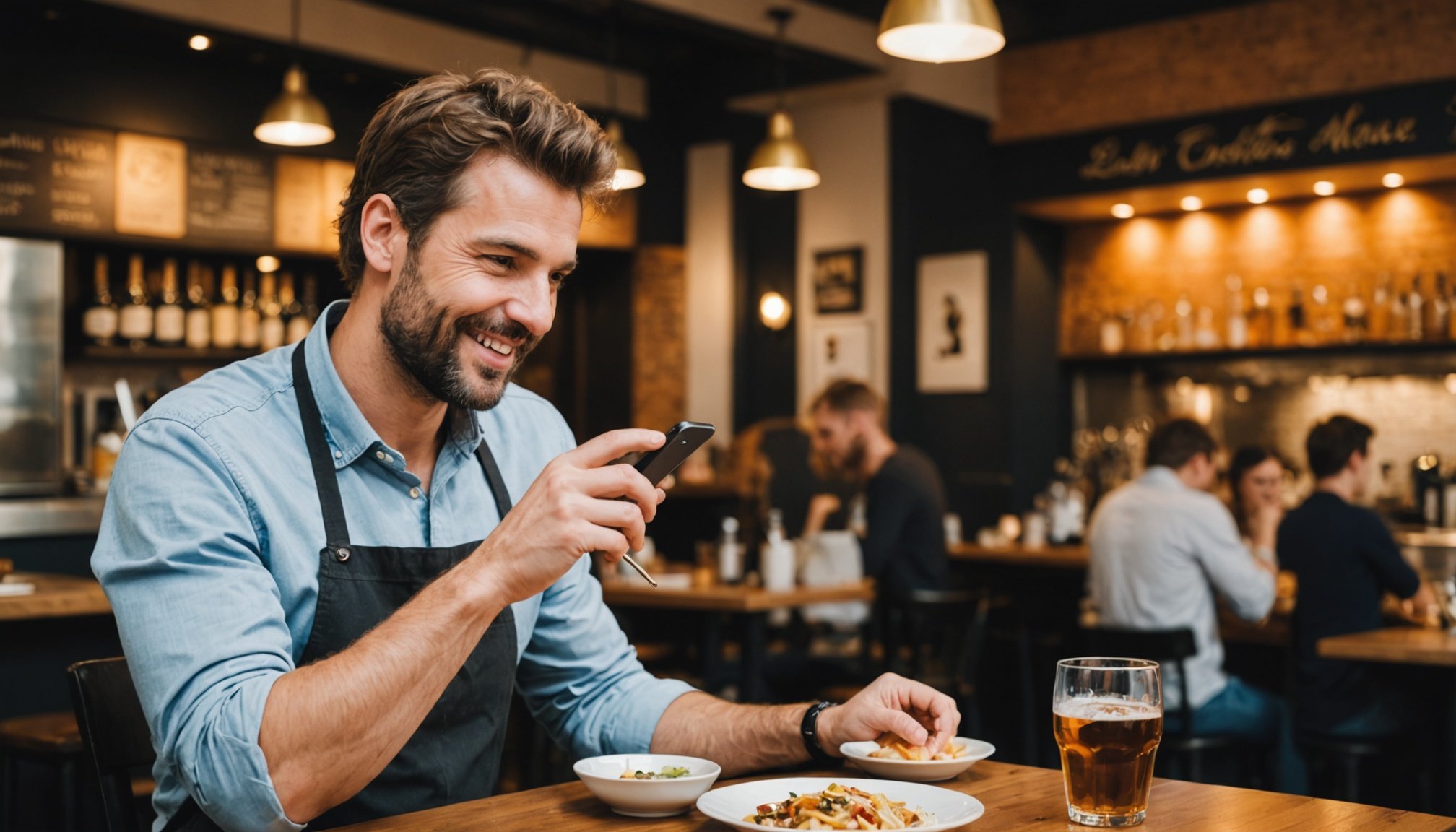Understanding the Current Online Ordering Landscape
The UK restaurant market has experienced a significant surge in online ordering, a trend many businesses are keen to capitalize on. With the rise of digital technology, customer behavior has shifted from traditional in-house dining to convenience-driven online platforms. In fact, statistics indicate that a growing number of consumers prefer the ease and speed offered by online ordering systems.
In this rapidly evolving landscape, understanding the key online ordering trends becomes crucial for restaurants aiming to capture and retain customers. This means scrutinizing customer behavior patterns—such as preferences for particular cuisines or meal times—can offer valuable insights. It also involves recognising the importance of adapting to these changing dynamics.
This might interest you : Effective Strategies to Reduce Cart Abandonment Rates for UK Online Retailers
For the UK restaurant market, staying ahead means more than just offering food online; it involves tailoring offerings to align with evolving preferences. Restaurants that embrace these changes and leverage online ordering trends effectively position themselves to benefit from increased sales and customer satisfaction. The importance of being responsive to these market shifts cannot be overstated as it plays a pivotal role in the long-term success of restaurants navigating the dynamic landscape.
Optimizing Your Menu for Online Sales
In a digital-first world, effective menu optimization is vital for restaurants tapping into the online market. Begin by identifying high-margin items that are not only popular but also cost-effective to prepare. These items contribute significantly to profitability and should be prominently featured in your online offerings.
Also to read : Ultimate Blueprint for Developing a Robust Disaster Recovery Plan for IT Firms in the UK
The key to drawing customers lies in crafting engaging menu descriptions. Use vivid language that highlights the unique flavours and quality ingredients, transforming simple dish names into tantalising invitations. This strategy is crucial for differentiating your menu in a crowded market and capturing the attention of potential customers.
Additionally, the organisation of your menu must cater to online user experiences. An intuitive layout that allows easy browsing and selection fosters a smooth transaction process. For instance, categorise items based on meal times or dietary preferences, making it simpler for customers to find what they’re looking for.
Incorporating these menu optimization techniques enhances the likelihood of converting casual browsers into committed buyers. By focusing on high-margin items and appealing descriptions, restaurants can elevate their online presence, boosting both sales and customer satisfaction in the burgeoning digital ordering landscape.
Leveraging Digital Marketing Strategies
In the age of technology, digital marketing is an essential tool for restaurants aiming to boost their online presence. Effectively leveraging platforms can significantly influence customer engagement and order volumes.
Utilizing Social Media Effectively
Social media offers an accessible avenue to reach customers where they spend much of their time. By crafting engaging posts and targeted social media campaigns, restaurants can increase visibility and entice potential patrons. Regular, varied content—like behind-the-scenes videos or customer testimonials—can foster a sense of community and pique interest in new menu items or promotions.
Creating Targeted Email Campaigns
Email marketing allows for personalised interactions, a proven method for retaining customers. Tailor your messages to reflect customer preferences or seasonal menus. Including exclusive deals or sneak peeks can encourage repeat business. Segmenting the audience ensures that content remains relevant and compelling, ultimately driving sales.
Enhancing Local SEO for Visibility
Implementing local SEO techniques ensures that your restaurant is easily discoverable in search results. Using local keywords and updating your restaurant’s online profiles with pertinent information increases the chances of capturing nearby customers ready to order. Consistent engagement across digital platforms enhances visibility and signals reliability to potential customers.
Building Strong Delivery Partnerships
As online ordering continues to rise, forming robust delivery partnerships is key to maintaining a seamless customer experience. To ensure a successful collaboration, evaluate potential delivery platforms based on their alignment with your business goals and capabilities. Look for partners with proven track records in efficiency and reliability.
Training staff to work cohesively with delivery services is another essential step. Familiarise them with the technology and protocols of your chosen platform to ensure seamless integration. This knowledge enables your team to manage orders efficiently, reflecting well on your brand’s professionalism.
Quality control forms the cornerstone of an excellent delivery experience. It is vital to establish protocols that maintain your meal’s integrity from kitchen to customer. Regular audits and customer feedback can help identify areas for improvement, promoting a consistently high standard.
Investing in strategic delivery partnerships not only enhances your operational efficiency but also elevates the overall satisfaction of your customers. By selecting the right partners and training your staff accordingly, you can offer a delivery experience that keeps customers coming back for more. As a result, this strengthens your reputation while boosting sales in the competitive UK restaurant market.
Enhancing Customer Engagement and Retention
Successful customer engagement is a pivotal aspect of the UK restaurant market’s digital strategy. Implementing effective loyalty programs can significantly drive repeat business. These programs incentivise customers by rewarding frequent purchases with discounts or exclusive offers. Crafting an enticing loyalty scheme fosters a sense of value and strengthens long-term relationships with your audience.
Beyond loyalty systems, feedback management is an essential tool for improving service and maintaining customer satisfaction. Soliciting genuine feedback provides valuable insights that guide adjustments to menu items or service quality. Encourage honest reviews through simple and accessible platforms, ensuring customers feel heard and valued.
Moreover, personalised communication plays a key role in retaining clientele. Tailor your messaging to reflect individual customer preferences and dining habits. Automated emails or targeted promotions based on past purchases can maintain ongoing interaction and interest. Such strategies not only enhance engagement but also demonstrate a deeper understanding of customer needs.
To summarise, by focusing on loyalty programs, feedback management, and personalised communication, restaurants can effectively cultivate a loyal customer base. This approach not only amplifies customer retention but also positions your brand as attentive and responsive to evolving consumer demands.
Case Studies and Proven Success Strategies
Exploring case studies of restaurants that have successfully increased their online orders provides valuable insights. These success stories reveal concrete steps that can lead to measurable outcomes.
Take the example of Restaurant A, which leveraged social media campaigns and effective menu optimization. By highlighting high-margin items through engaging posts and strategic use of appealing descriptions, they saw a 30% increase in online sales within three months. This involved not just advertising their dishes but also showcasing unique features and customer experiences that resonated with their audience.
Restaurant B focused on delivery partnerships to enhance the customer experience. They selected delivery platforms that aligned with their streamlined operations, coupled with rigorous staff training, to ensure smooth deliveries. The result was a noticeable improvement in customer satisfaction and repeat orders.
Successful implementations of loyalty programs and targeted email marketing were also observed. By analysing performance metrics, these restaurants adapted and refined their strategies to sustain growth. Through these success stories, it’s clear that tailored strategies and continuous monitoring are significant drivers in boosting online order performance.
Monitoring Performance and Adapting Strategies
To maintain a competitive edge, restaurants must embrace performance tracking to refine their online strategies constantly. Using advanced analytics tools, you can gain valuable insights into how online orders are progressing. These tools allow you to monitor order volume, customer demographics, and sales trends effectively.
Analyzing data from these analytics provides an opportunity to evaluate which strategies are profitable and which require adjustments. It enables restaurants to identify high-performing items or marketing campaigns, ensuring resources are allocated effectively. Consider the technologies that allow for real-time monitoring and can adapt to changing trends, which is essential in a swift digital landscape.
Tools such as POS systems and data dashboards can collect and display this critical information. Utilizing the customer insights gleaned from these analyses can guide future decision-making. For instance, if a specific promotion attracts more new customers, consider modifying it to engage repeat business.
By focusing on continuous improvement, restaurants can not only enhance customer satisfaction but also drive sales. Regular feedback loops and strategic adjustments based on data can lead to more effective online sales strategies, ensuring long-term success in the evolving UK restaurant market.











